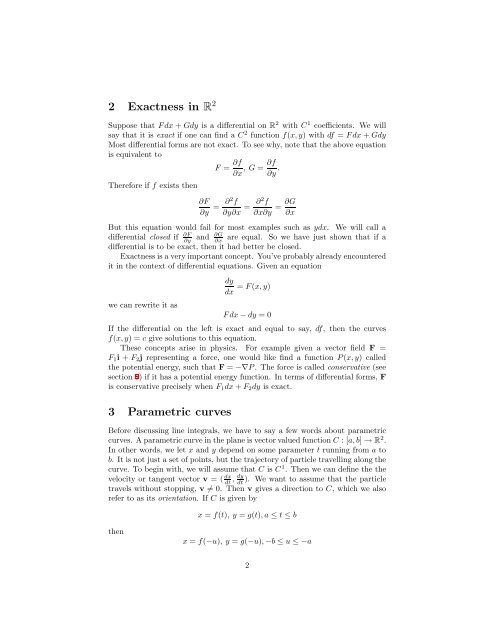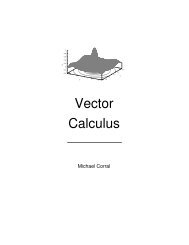Introduction to differential forms
Introduction to differential forms
Introduction to differential forms
Create successful ePaper yourself
Turn your PDF publications into a flip-book with our unique Google optimized e-Paper software.
2 Exactness in R 2<br />
Suppose that F dx + Gdy is a <strong>differential</strong> on R 2 with C 1 coefficients. We will<br />
say that it is exact if one can find a C 2 function f(x, y) with df = F dx + Gdy<br />
Most <strong>differential</strong> <strong>forms</strong> are not exact. To see why, note that the above equation<br />
is equivalent <strong>to</strong><br />
F = ∂f<br />
∂x , G = ∂f<br />
∂y .<br />
Therefore if f exists then<br />
∂F<br />
∂y = ∂2 f<br />
∂y∂x = ∂2 f<br />
∂x∂y = ∂G<br />
∂x<br />
But this equation would fail for most examples such as ydx. We will call a<br />
<strong>differential</strong> closed if ∂F ∂G<br />
∂y<br />
and<br />
∂x<br />
are equal. So we have just shown that if a<br />
<strong>differential</strong> is <strong>to</strong> be exact, then it had better be closed.<br />
Exactness is a very important concept. You’ve probably already encountered<br />
it in the context of <strong>differential</strong> equations. Given an equation<br />
we can rewrite it as<br />
dy<br />
= F (x, y)<br />
dx<br />
F dx − dy = 0<br />
If the <strong>differential</strong> on the left is exact and equal <strong>to</strong> say, df, then the curves<br />
f(x, y) = c give solutions <strong>to</strong> this equation.<br />
These concepts arise in physics. For example given a vec<strong>to</strong>r field F =<br />
F 1 i + F 2 j representing a force, one would like find a function P (x, y) called<br />
the potential energy, such that F = −∇P . The force is called conservative (see<br />
section 8) if it has a potential energy function. In terms of <strong>differential</strong> <strong>forms</strong>, F<br />
is conservative precisely when F 1 dx + F 2 dy is exact.<br />
3 Parametric curves<br />
Before discussing line integrals, we have <strong>to</strong> say a few words about parametric<br />
curves. A parametric curve in the plane is vec<strong>to</strong>r valued function C : [a, b] → R 2 .<br />
In other words, we let x and y depend on some parameter t running from a <strong>to</strong><br />
b. It is not just a set of points, but the trajec<strong>to</strong>ry of particle travelling along the<br />
curve. To begin with, we will assume that C is C 1 . Then we can define the the<br />
velocity or tangent vec<strong>to</strong>r v = ( dx ). We want <strong>to</strong> assume that the particle<br />
travels without s<strong>to</strong>pping, v ≠ 0. Then v gives a direction <strong>to</strong> C, which we also<br />
refer <strong>to</strong> as its orientation. If C is given by<br />
dt , dy<br />
dt<br />
x = f(t), y = g(t), a ≤ t ≤ b<br />
then<br />
x = f(−u), y = g(−u), −b ≤ u ≤ −a<br />
2








